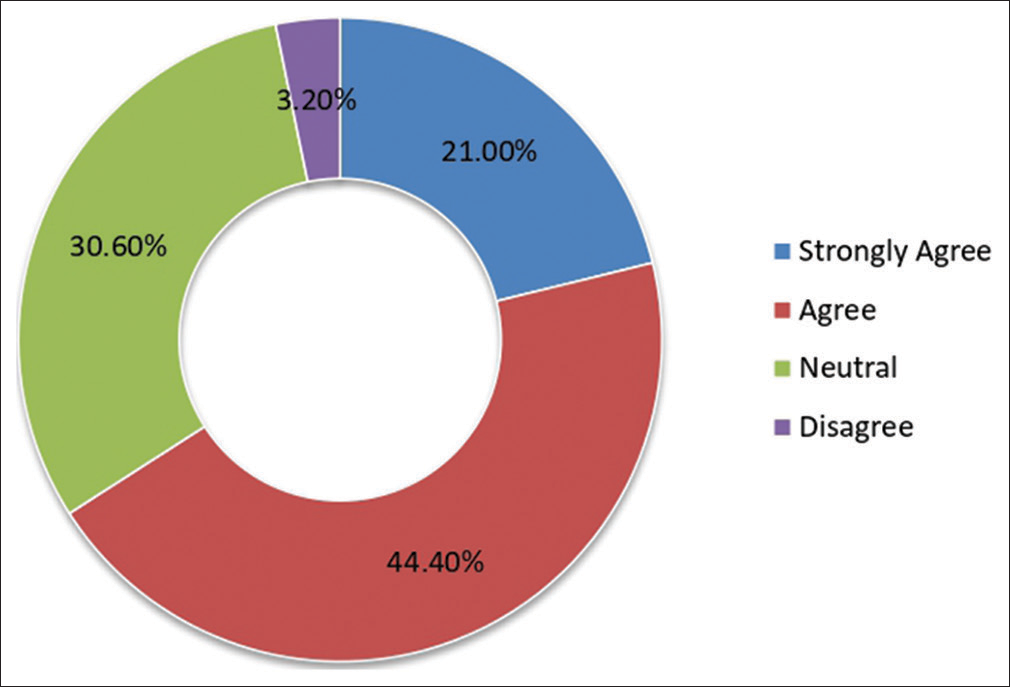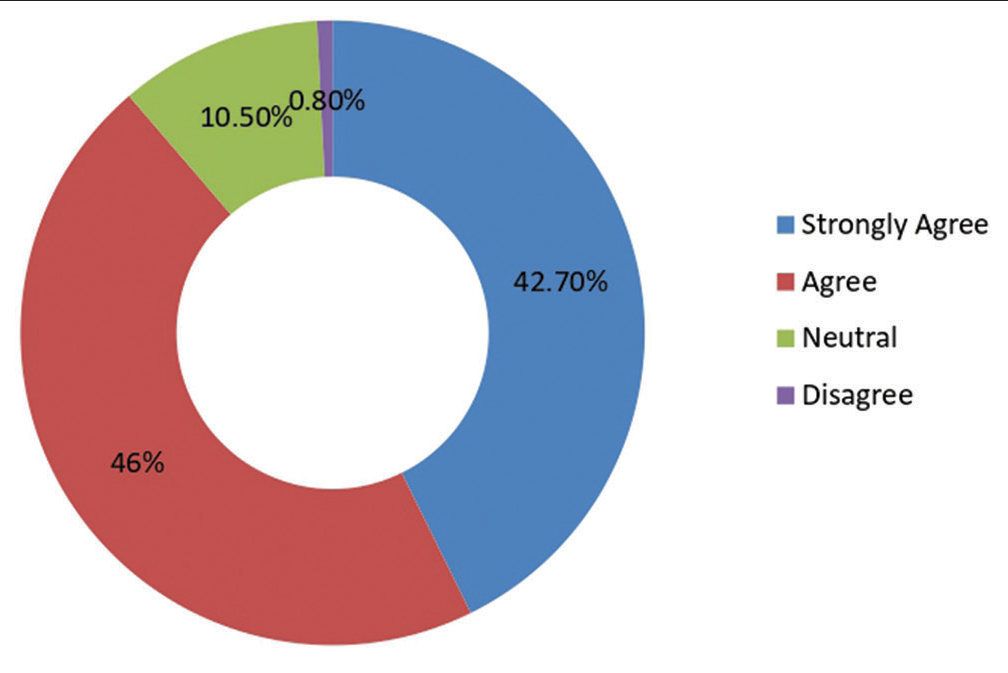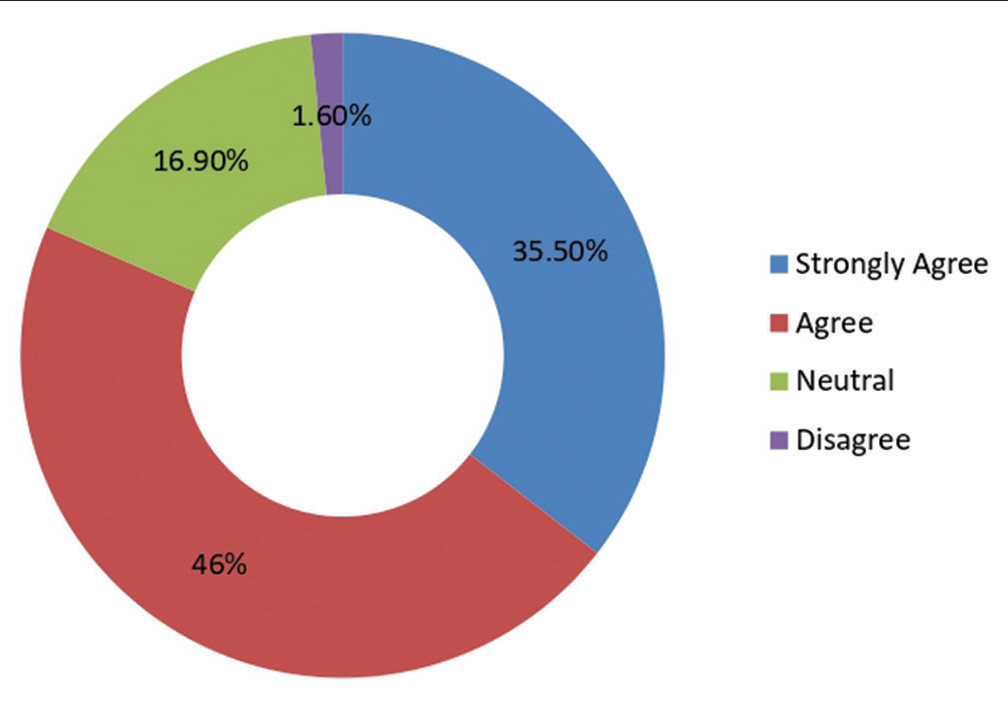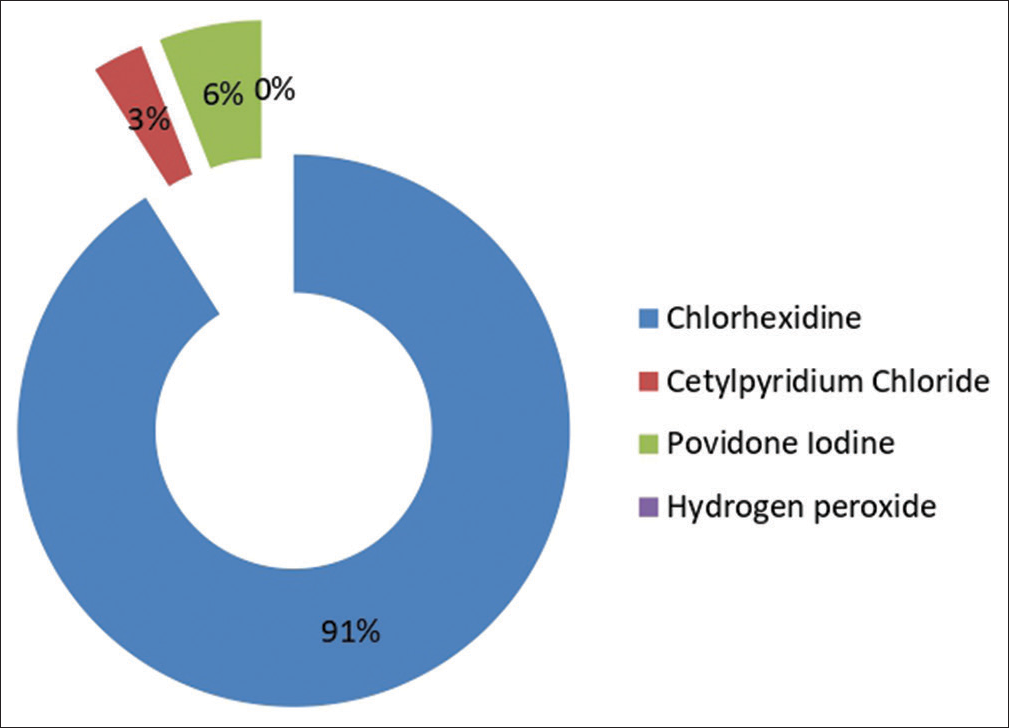Translate this page into:
Assessment regarding dental practitioners’ knowledge, attitude, and practices towards pre-procedural mouth rinse during COVID-19 pandemic – A cross-sectional study in Tamil Nadu

*Corresponding author: Ms. Samyu Krishnakumar, CRRI, Department of Oral Pathology and Microbiology, Sri Ramakrishna Dental College and Hospital, Coimbatore, Tamil Nadu, India. samyukrishnakumar@gmail.com
-
Received: ,
Accepted: ,
How to cite this article: Krishnakumar S, Marimuthu V, Shanmugasundaram G. Assessment regarding dental practitioners’ knowledge, attitude, and practices towards pre-procedural mouth rinse during COVID-19 pandemic – A cross-sectional study in Tamil Nadu. J Academy Dent Educ. 2023;9:54-8. doi: 10.25259/JADE_45_2022
Abstract
Objectives:
Evolving strains of SARS-CoV-2 causing the COVID-19 disease has challenged the scientific world in limiting the disease and curbing the pandemic. Several factors such as increased salivary viral load in COVID-infected patients, procedures generating aerosols put the dental professionals at high risk of acquiring the disease. The present study aims to assess the knowledge, attitude and practices regarding the use of pre-procedural mouth rinse among the dental practitioners in Coimbatore.
Material and Methods:
A descriptive, cross-sectional study was conducted among dental practitioners in Coimbatore using a pre-validated questionnaire which comprised of sections interrogating knowledge, awareness, and practice of the use of pre-procedural mouth rinse in dental setup. One hundred and twenty-five dental practitioners in Coimbatore responded to the questionnaire.
Results:
Assessment of knowledge regarding the effectiveness of pre-procedural mouthwashes in reducing the bacterial and viral load was 97%. About 89% of dental practitioners were aware of the superior antimicrobial properties of Povidone Iodine in comparison with Chlorhexidine. Only 65% of dental practitioners used pre-procedural mouthwashes in practice.
Conclusion:
There is high inquisitiveness among dental practitioners in acquiring knowledge regarding preventive measures for SARS-CoV-2 alike the use of pre-procedural mouth rinses in reducing the viral load in COVID-19 infected patients. Although there is high awareness, there exists reluctance in implementing the knowledge acquired in real practice.
Keywords
COVID-19
Dental procedures
Mouthwash
Povidone-iodine
INTRODUCTION
Despite numerous efforts to eradicate the virus, the SARS-CoV-2 virus, which caused the COVID-19 disease outbreak in 2019, is still causing global pandemics. The highly infective SARSCoV-2 enters the host cells via angiotensin converting enzyme-2 (ACE-2) receptors which show high degree of affinity to viral surface S-protein.[1] ACE-2 receptors are profoundly expressed by the oral epithelial cells which pose a greater likelihood of infectivity and portal of entry to lower respiratory organs and gastrointestinal tract.[2] Saliva of COVID-19 patients contains about 1.2 × 108 infective copies/mL of SARS-CoV-2 virus particle, which contributes substantially to the transmission of infection through infected droplets. Smaller droplets containing virus particles are spread through inhalation, whereas the larger droplets may settle on surfaces resulting in contact transmission.[3] Virus particles in droplets possess a half-life of 1.1 h, which poses a high risk of infection.[4] Health professionals, particularly dentists, are more vulnerable to the disease as most dental procedures release aerosols and also are performed in close proximity to patients. It is the need of the hour for dentists to adopt ample precautionary measures. One such preventive measure under trial is the application of mouth rinses before any dental procedures.
In the pre-COVID period, dentists considered the use of mouthwashes, preferably those containing chlorhexidine, in periodontal problems to limit the bacterial infections. American Dental Association (ADA) in April 2020 proposed the use of pre-procedural mouthwashes containing Hydrogen Peroxide and 0.2% Povidone Iodine (PVP-I) to contain the spread of SARS-CoV-2 infection in a dental setting.[5] PVP-I outperforms chlorhexidine in experimental studies on the effectiveness of mouthwashes in lowering SARS-CoV-2 viral load.[3] In addition, it was discovered that SARS-CoV-2 variants can be effectively treated with cetylpyridinium chloride.[6] These antiviral mouthwashes work by rupturing the lipid envelope of SARS-CoV-2 that contains spiked proteins, which disrupts the virus’s ability to attach to the host cell.[7] Adaptive ability of COVID-19 virus has played a pivotal role in emerging strains of the virus ranging from Alpha to Mu and many more to come. Simple precautionary measures like antiviral mouthwashes whose mechanism of action are effective against any strain of the virus can be adopted in dental practice to curb the infection. The present study aims to assess the knowledge, attitude, and practices regarding the use of mouth rinse among the dental practitioners in Coimbatore.
MATERIAL AND METHODS
A descriptive cross-sectional study was conducted among dental practitioners in Coimbatore from September to December 2021. Ethical clearance was obtained from the Institutional Ethical Board (Ref. No. EC/2021/1108/CR/64). Sample size was estimated using power sampling. One hundred and twenty-five dental practitioners in Coimbatore were randomly sampled. Dental professionals who volunteered to participate in the study were informed of its objectives, and their informed consent was obtained. A validated questionnaire (Cronbach’s alpha value: 70.3%) based on the use of pre-procedural mouthwashes in dental operative procedures was adopted from Imran et al.[8] The questionnaire layout was designed using Google forms which comprised of three sections interrogating the Knowledge, awareness, and practice of the use of pre-procedural mouth rinse in dental setup. The first section comprised of eight questions on the knowledge with yes or no options to the respondents, the second section had two questions that addressed the attitude designed on 5-point Likert scale and the third section was directed toward practice, with two close-ended questions designed on 5-point Likert scale and one open-ended question. A link was created for the questionnaire and distributed through e-mail and WhatsApp among dental practitioners in Coimbatore and the responses were recorded. Frequency and percentage were estimated for all categorical variables.
RESULTS
Dental practitioners in Coimbatore were well aware of the transmissibility of SARS CoV2 virus through aerosols in a dental setting [Figure 1]. About 97% of participants agreed that the use of pre-procedural mouth rinse reduces the microbial overload in dental aerosols. Participants were also familiar that PVP-I mouthwashes have high virucidal activity and are way more effective than Chlorhexidine [Table 1]. However, only 73.4% agree that these offer promising results against transmission of all mutated strains of SARS-CoV-2 virus [Figure 2]. 89% of the dental practitioners provided patient education on COVID-19 transmission [Figure 3]. Although all participants were acquainted regarding the virucidal activity of mouthwashes, <50% of practitioners actually used pre-procedural mouthwashes during dental operative procedures [Figure 4]. Moreover, those practitioners implementing pre-procedural mouth rinse in dental procedures recommended the use of Chlorhexidine than PVP-I [Figure 5].

- Attitude assessment regarding dentists being at the highest risk of exposure to SARS-CoV-2.
| S. No. | Knowledge Items | Yes (%) | No (%) |
|---|---|---|---|
| 1 | Transmission of SARS CoV-2 is mainly via respiratory droplets and aerosols during a dental procedure? | 98 | 2 |
| 2 | Aerosols produced during the dental treatment can reach alveoli in lungs causing respiratory problems? | 95 | 5 |
| 3 | Aerosols remain in the air for at least 10 minutes after the dental procedure and have the capacity to spread to a distance of at least 2 feet from the dental chair? | 96 | 4 |
| 4 | Mouthwashes offer promising results against coronavirus transmission, as they have the potential to destroy the lipid membrane of the virus, thus effective against all mutated COVID- 19 strains? | 73 | 27 |
| 5 | Pre-procedural use of mouthwashes can effectively reduce the bacterial and viral load in the dental aerosols? | 97 | 3 |
| 6 | Mouthwashes constituting Povidone-Iodine (PVP-I) are more efficient in reducing Coronavirus than Chlorhexidine (CHX) mouthwashes? | 88 | 12 |
| 7 | 0.23% PVP-I showed significant virucidal activity against SARS-CoV, MERS-CoV, influenza virus and rotavirus? | 86 | 14 |
| 8 | Cetylpyridinium chloride (CPC) oral rinses remain effective in the oral cavity for up to 180 to 300 minutes? | 83 | 17 |

- Attitude assessment regarding control of COVID-19 spread using pre-procedural mouthwash during dental operative procedures.

- Practice assessment regarding patient education on COVID-19 transmission.

- Practice of using pre-procedural mouthwash during COVID-19 pandemic.

- Practice assessment regarding recommended mouthwash before any dental procedures.
DISCUSSION
COVID-19 is now a worldwide threat to the general public and healthcare workers, particularly dental practitioners. Primary spread of the virus through oral aerosols and sustainability of the viruses in the air for longer durations put dental practitioners at high risk of acquiring COVID-19. At the initial outbreak of COVID-19 pandemic, dental operative procedures were temporarily suspended fearing high vulnerability to aerosol transmission. In September 2021, the Ministry of Health and Family Welfare proposed guidelines for dental practice, which included infection prevention protocols for aerosols such as high vacuum suction, face shield, rubber dam, and the use of pre-procedural mouth rinses.[9] Following the proposition of these guidelines, dental operative procedures were gradually reverted to practice. At each phase of the emergence of new variants of SARS-CoV-2 virus, frequent modifications were made in the existing protocols for infection prevention in dental clinics. It is of prime need to be aware of, adapt, and follow the proposed protocols in dental practice to contain the transmission. The study reveals the knowledge, attitude, and practice of utilizing pre-procedural mouth rinses among the dental practitioners in Coimbatore [Figures 1-5].
An understanding of the mechanism of disease transmission is essential for effective containment of the disease. About 98% of the practitioners were cognizant that COVID-19 spread during dental procedures was mainly through respiratory droplets and aerosols. This is similar to the results of the studies by Imran et al., Tariq et al., Arif et al.[8,10,11] However, a similar study from Chennai recorded only 78% awareness regarding COVID-19 transmission through aerosols and respiratory droplets,[12] which signifies the demographic differences in knowledge among practitioners in the same state of India.
Saliva of COVID-19-infected individuals contains SARS-CoV-2 virus particles, at phases even when the affected individual remains asymptomatic. The virions in saliva and respiratory fluids can be transmitted via droplets and aerosols containing virus particles of about 5–10 mm. Aerosols spread through contact transmission and/or inhalation in a close range of about 2 m, which makes the aerosol generating dental procedures at high risk for disease transmission. Aerosol particles may get deposited on surfaces or sensitive tissues such as eyes, bronchi, and distal lung and cause infection.[13] Similar to the study by Imran et al., which found that 75% of practitioners responded positively to awareness, 95% of practitioners were aware that aerosols generated during dental procedures could be transported to the lower respiratory system and cause respiratory issues.[8]
About 73% of practitioners were aware that mouthwashes offer promising results against different strains of SARS-CoV-2. This is in contrary to the study by Imran et al. were only 33% of participants were aware of the effectiveness of mouthwashes against all strains of COVID-19.[8] About 97% of participants knew that using mouthwashes before procedures can significantly lower the number of bacteria and viruses in dental aerosols. Similar studies conducted by Tariq et al. in 2021 and Imran et al. in 2020 show a gradual increase in awareness about the beneficial effects of pre-procedural mouth rinse in lowering bacterial and viral load.[8,10]
Pre-procedural mouthwashes have been shown to reduce the risk of transmission to dentists while also improving systemic problems associated with altered oral microbiome.[3] Mouthwashes containing PVP-I has been proven to be potent in reducing SARS-CoV-2 viral load in vivo and in vitro.[14,15] About 86% of the practitioners were aware that 0.23% PVP-I showed significant virucidal activity against SARS-CoV, MERS-CoV, Influenza virus, and rotavirus, representing higher percentage of awareness among the study population compared to 34% in a similar study by Imran et al.[8] Although chlorhexidine was the commonly preferred mouthwash in the pre-COVID phase to restrict the bacterial load, the efficacy of chlorhexidine against viruses is estimated to be less than PVP-I.[3] In the present study, 88% of dental practitioners had prior knowledge that PVP-I is more efficient in reducing coronavirus than chlorhexidine mouthwash depicting a better apprehension in contrast to similar studies by Imran et al., Naveed et al., and Arif et al.[8,11,12] Results from experimental in vitro studies show that mouthwashes containing 0.05% Cetylpyridinium chloride (CPC) efficiently reduce viral load of variant strains of SARS-CoV-2.[6] About 83% of study participants had known that CPC oral rinses remain effective for up to 180–300 min in the oral cavity in contrary to 31% reported by Imran et al.[8]
Assessment of the attitude of dental practitioners toward the use of pre-procedural mouthwashes showed that 89% agreed that dental professionals had the highest possibility of acquiring COVID-19 disease. Only 34% believed that pre-procedural mouthwashes could control the transmission of COVID-19 disease in the practice environment, highlighting a decline in trust in pre-procedural mouth rinses’ ability to combat SARS-CoV-2. Assessment of practice exhibited that 89% practitioners provided health education to their patients regarding COVID-19 disease and transmission. About 65% used pre-procedural mouthwashes in their practice, among which 50% recommended chlorhexidine mouthwash before dental procedures, drawing a line between knowledge and practice regarding the use of pre-procedural mouth rinses during COVID-19.
CONCLUSION
There is high inquisitiveness among dental practitioners in acquiring knowledge regarding preventive measures for SARS-CoV-2 like the use of pre-procedural mouthwashes in lowering the viral load in COVID-19 infected patients. Although there is high awareness, there exists reluctance in implementing the knowledge acquired in real practice. When simple procedures such as pre-procedural mouth rinses can provide effective reduction in viral load, the study highlights the need for change in practice that can help contain COVID-19 infection at present and in future.
Ethical approval
The authors declare that they have taken the Institutional Ethical Board approval and the approval number is EC/2021/1108/CR/64.
Declaration of patient consent
Patient’s consent not required as there are no patients in this study.
Conflicts of interest
There are no conflicts of interest.
Use of artificial intelligence (AI)-assisted technology for manuscript preparation
The authors confirm that there was no use of artificial intelligence (AI)-assisted technology for assisting in the writing or editing of the manuscript and no images were manipulated using AI.
Financial support and sponsorship
Nil.
References
- Interaction of SARS-CoV-2 and other coronavirus with ACE (Angiotensin-Converting Enzyme)-2 as their main receptor: Therapeutic implications. Hypertension. 2020;76:1339-49.
- [CrossRef] [PubMed] [Google Scholar]
- Oral mucosa could be an infectious target of SARS-CoV-2. Healthcare (Basel). 2021;9:1068.
- [CrossRef] [PubMed] [Google Scholar]
- Antiviral mouthwashes: possible benefit for COVID-19 with evidence-based approach. J Oral Microbiol. 2020;12:1794363.
- [CrossRef] [PubMed] [Google Scholar]
- Airborne aerosols particles and COVID-19 transition. Environ Res. 2021;200:111752.
- [CrossRef] [PubMed] [Google Scholar]
- Use of mouthwashes against COVID-19 in dentistry. Br J Oral Maxillofac Surg. 2020;58:924-7.
- [CrossRef] [PubMed] [Google Scholar]
- Mouthwashes with CPC reduce the infectivity of SARS-CoV-2 variants in vitro. J Dent Res. 2021;100:1265-72.
- [CrossRef] [PubMed] [Google Scholar]
- The effectiveness of mouthwash against SARS-CoV-2 infection: A review of scientific and clinical evidence. J Formos Med Assoc. 2022;121:879-85.
- [CrossRef] [PubMed] [Google Scholar]
- Dental practitioners' knowledge, attitude and practices for mouthwash use amidst the COVID-19 pandemic. Risk Manag Healthc Policy. 2021;14:605-18.
- [CrossRef] [PubMed] [Google Scholar]
- National Guidelines for Safe Dental Practice during Covid-19 Pandemic. Available from: https://www.mohfw.gov.in/pdf/nationalguidelinesforsafedentalpracticeduringcovid19pandemic.pdf
- [Google Scholar]
- Common misconceptions regarding COVID-19 among health care professionals: An online global cross-sectional survey. J. Oral Res. 2020;2:36-45.
- [CrossRef] [Google Scholar]
- A study to assess the knowledge and perception of practicing dental professionals toward COVID-19 in Lucknow City. J Maxillofac Oral Surg. 2021;21:1-11.
- [CrossRef] [PubMed] [Google Scholar]
- Awareness of COVID-19 among dental students in Chennai, India-A questionnaire based study. Eur J Mol Clin Med. 2020;7:1620-5.
- [Google Scholar]
- Airborne aerosols particles and COVID-19 transition. Environ Res. 2021;200:111752.
- [CrossRef] [PubMed] [Google Scholar]
- Is povidone iodine mouthwash effective against SARS-CoV-2? First in vivo tests. Oral Dis. 2022;28(Suppl 1):908-911.
- [CrossRef] [PubMed] [Google Scholar]
- Is there scientific evidence of the mouthwashes effectiveness in reducing viral load in Covid-19? A systematic review. J Clin Exp Dent. 2021;13:e179-89.
- [CrossRef] [PubMed] [Google Scholar]






